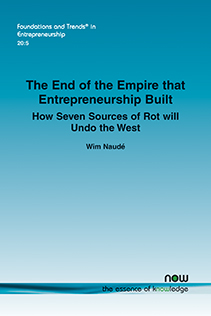The End of the Empire that Entrepreneurship Built: How Seven Sources of Rot will Undo the West
By Wim Naudé, RWTH Aachen University, Germany, Naude@time.rwth-aachen.de
Abstract
The West is the empire that entrepreneurship built. All empires in the past have at some point collapsed. In recent years attention has been turning to concerns that the global economy is facing the polycrisis, and that collapse may be imminent. In this light, this monograph argues that there are at least seven sources of rot that affect entrepreneurship. These sources of rot follow from an analysis of the sources of rot which led to the collapse of the Soviet Union. It is argued that all of these sources of rot are relevant in the West. The West has an increasingly powerful military-industrial complex which thrives on a Warfare Economy, science and research are declining, innovation is being disincentivised, the West is becoming a stop-button society that is seeing technological conservatism just when new technological innovations may most be needed, and the flow of information is increasingly hampering the role of entrepreneurs as knowledge spillover conduits as well as the functioning of democracy. While these factors impacted the Soviet Union, the West is now also facing the end of the hydrocarbon age and has to face the consequences of the financialization of the economy. From the analyses of how these sources of rot undermine entrepreneurial growth, follows two implications. One is that, given that the underlying sources of rot are similar in outline in an empire that has been built by entrepreneurship, and in an empire that has not been, then entrepreneurship is not a solution to avert collapse. A second is that if collapse is not extinction, it may be a reset to a system that has become too costly and too exploitative to maintain. Collapse may be welcomed, and may even be a feature, and not a “bug” of the evolution of society. These implications suggest that the West should be getting busy with succession planning.
The End of the Empire that Entrepreneurship Built: How Seven Sources of Rot will Undo the West
The End of the Empire that Entrepreneurship Built argues that concerns about the collapse of the West need to be taken seriously and that there are at least seven sources of rot that affect how entrepreneurship, the builder of the West, continues to play a role in shaping society. To identify and analyze the sources of this rot, this monograph takes a somewhat different approach than has been taken so far in the literature by drawing parallels between the rot affecting the West and the rot that caused the collapse of the Soviet Union.
In drawing the parallels with the Soviet Union, this work follows Chan's (2015) categorization of the five sources of rot that ended the Soviet Union and adds two further sources that are prominent in the West. These include increasing militarization; the ideological undermining of science; the disincentivizing of innovation; "technological conservatism"; a centralizing hierarchy that obstructed the horizontal flow of information; the end of the hydrocarbon age - the energy transition out of cheap fossil fuels; and the financialization of the economy - the bankers' takeover. These seven sources of rot are argued to be the main harbingers of the collapse of the West. Understanding these better may help inform the debate that is needed on succession planning so as to minimize the damages that can be caused by collapse, and moreover to manage post-collapse recovery.
The monograph is structured as follows. Section 2 explains why entrepreneurship has been the builder of the West's empire that arose roughly around the 1800s. Section 3 asks, does the fate of the Soviet Union await the West? This section also discusses the seven sources of rot. Section 4 draws together the conclusions from the discussion of these sources of rot to explain how they represent scenario spoilers for the optimistic scenarios of an entrepreneurial economy. Section 5 provides the conclusion.
